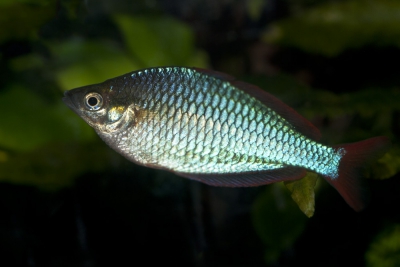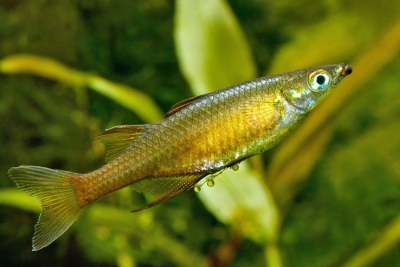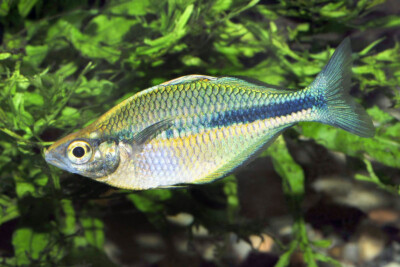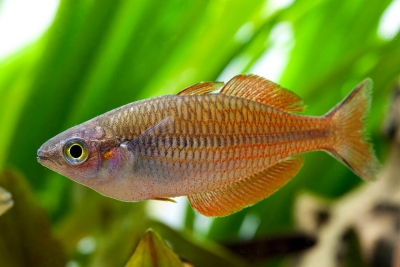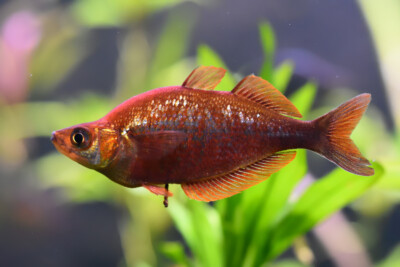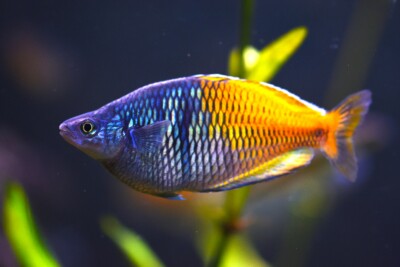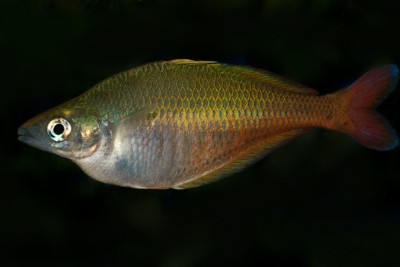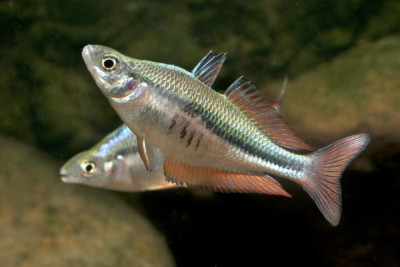barred rainbowfish
| Scientific name | Chilatherina fasciata |
|---|---|
| Descriptor | Weber |
| Year of description | 1913 |
| IUCN category (World) | LC |
| Family | Melanotaeniidae |
| Genus | Chilatherina |
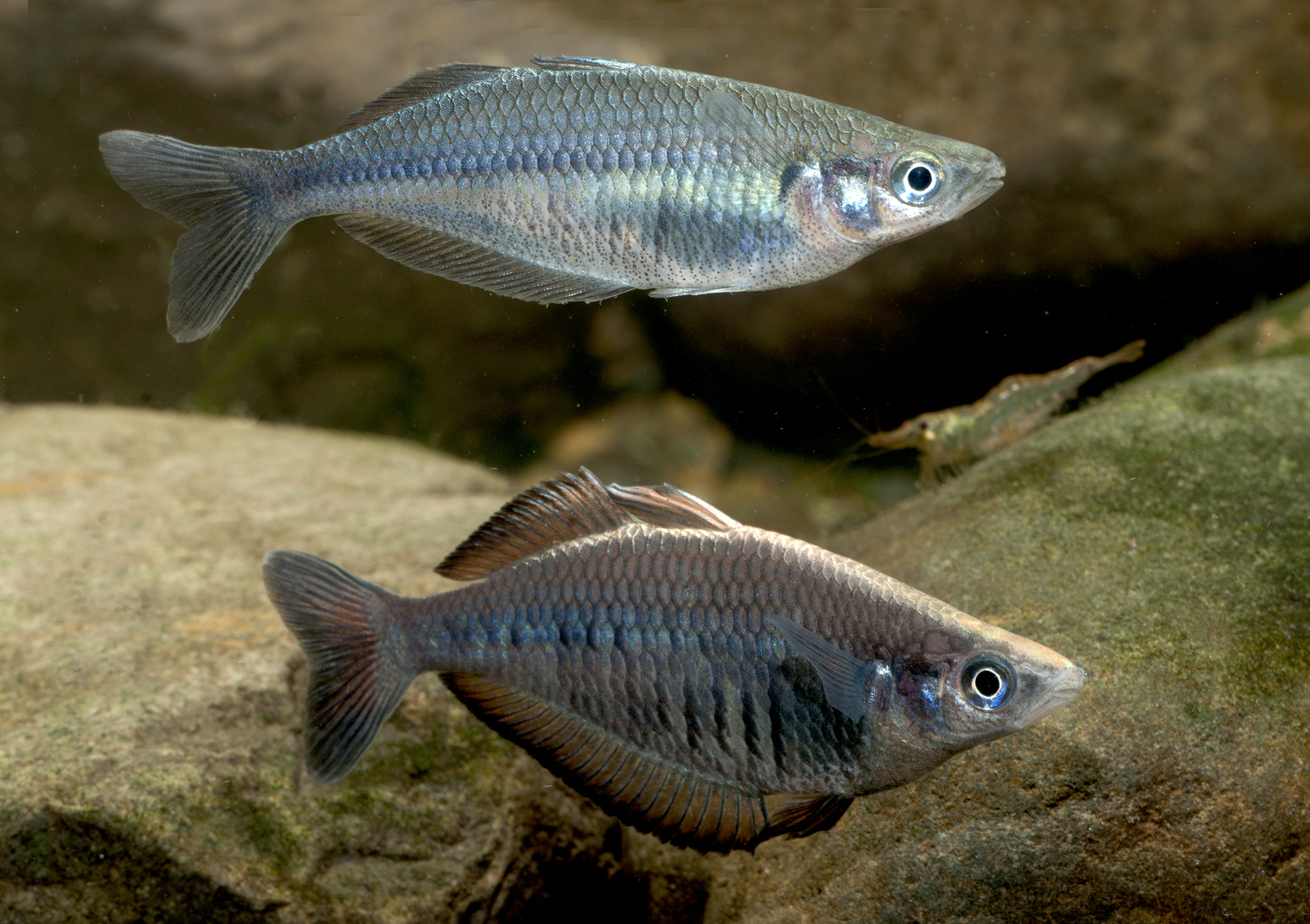

Introduction
Chilatherina fasciata is a freshwater tropical fish native to northern New Guinea. It is commonly known as the barred rainbowfish or orange rainbowfish. It is morphologically similar to its congener C. pagwiensis but surpasses it in size and number of fin rays.
Like its close cousins, C. fasciata is an omnivorous fish with an insectivorous tendency. This species is sometimes encountered in the aquarium hobby, especially among Melanotaeniidae enthusiasts.
Who is it?
Morphology
-
Average size10 cm
-
Maximum size12 cm
-
Average size10 cm
-
Maximum size12 cm
How to recognize This fish ?
Isolation of populations among large river systems has led to the emergence of numerous subpopulations with various color patterns. The body is typically brown to greenish, with iridescent or bluish reflections. The underside is silvery to yellowish. The mid-lateral stripe is darker. In males, several dark bars are often present on the flanks.
These fish rarely exceed 11 cm in the wild.
Sexual dimorphism
Easily distinguishable, males are larger and more colorful than females. Females have a more slender body and sharper fins.
The dorsal and anal fins of mature males are particularly colorful, ranging from yellow to dark red / brown.
Behaviour & Life cycle
-
dietomnivorous with carnivorous tendency
-
Sociabilityliving in small groups
-
territorialNo
-
Way of livingdiurnal
These fish typically live in dispersed groups in the clear waters of tropical forest streams. They primarily feed on aquatic microorganisms, larvae, and terrestrial insects (ants, beetles, etc.).
Non-territorial or only slightly territorial, these fish lead a rather gregarious lifestyle, with no particular aggression between con-specifics.
Reproduction
-
Reproductionovipare qui pond en eau libre
-
PolygamyYes
The barred rainbowfish is an oviparous fish that spawns in open water. Sexual maturity is reached at 4 cm for females, 5 cm for males.
Harmless species
This species does not pose a specific danger to humans in its natural environment.
Origin and distribution
Geographic distribution & Conservation
Although restricted to northern New Guinea, it is one of the most abundant Chilatherina species on the island. The type population comes from the Sermowai River. It is also found in the Ramu, Sepik, Mamberamo, Markham, and Pual rivers.
It has been introduced, probably through the ornamental fish trade, to Lake Sentani where it could compete with and threaten the red rainbowfish Glossolepis incisus.
Conservation status of populations (IUCN)
What is its habitat?
Natural environment characteristics
-
Temperature28 - 32 °C
-
pH (acidity)6.4 - 8
-
gh (hardness)9 - 19
-
FlowStagnant
Biotope presentation
This species generally occurs in backwater areas of tropical forest streams. It is also found in calm, sun-exposed waters with dense vegetation.
The substrate is mainly sand and gravel, with a light layer of decomposing vegetation (leaves, roots, etc.).
Species of the same biotope
Main recommendations for fishkeeping
Deontology
In order to preserve wildlife, if you acquire this animal, it must not be released into the wild. See also, the Fishipedia charter.
Fishipedia supports the practice of responsible and environmentally friendly aquarium keeping. We encourage maintenance if it is motivated by a desire to understand the biological functioning of living things and if it is done with respect for animal life.
We believe that aquaristics is an opening to the discovery of aquatic environments, especially freshwater, and that this knowledge is necessary to better protect and respect these environments. Logically, we refute the compulsive purchase of animals that would not find a sufficient and / or adapted place in the host aquarium.
Our recommendationsThese tips apply to adult species from breeding. With regards to water conditions, wild species or close relatives must be kept under the same conditions as in their area of origin.
-
Min volume200 liters
-
Population min5
-
Temperature28 - 32 °C
-
pH (acidity)6.4 - 8
CharacteristicsThe characteristics below apply for adult species. They correspond to an average of cases, validated in maintenance condition.
-
Difficulty breedingThe farming difficulty is relative. It depends on experiments already carried out with similar species. First, it takes into consideration the robustness of the species, the ease of recreation of a favorable environment and the general behaviour with the other inhabitants of the aquarium.unknown
-
Robustnesstolerant
-
Behaviourpeaceful
-
Availabilityoccasional
Recommended equipment from our partners
-
Aquarium
-
Filtration
General reminders
It is strongly advised to read the complete dedicated file and to get information on the feedbacks of maintenance of the envisaged animal, this to avoid any potential conflict whose end result is generally the death of the individual (or the other inhabitants). It is important not to overload your aquarium to limit pollution. This will make maintenance easier.
In nature, animals are subject to weather conditions and live in waters with variable characteristics. The recommendations offered by our team for aquarium maintenance are a guidance and cannot be assimilated to scientific datas.
General reminder on maintenance datas
Le démarrage d'un aquarium est une partie primordiale pour l'équilibre et le bien-être des poissons. Lorsque l'on met en eau un aquarium, l'eau passe naturellement par un cycle biologique : le cycle de l'azote. Celui-ci dure environ trois semaines. Tous les 2 jours, nous vous conseillons de tester votre eau jusqu'à ce que le taux de nitrite soit à zéro pendant plusieurs jours d'affilée.
Pour accélérer ce cycle, vous pouvez utiliser un activateur de bactéries comme JBL Denitrol. Cette solution riche en bactéries vivantes et enzymes permet une mise en place rapide du cycle de l'azote. Les poissons peuvent alors être introduits plus rapidement.
Il est important de tester l'eau de son aquarium régulièrement pour maintenir un environnement sain pour les poissons et les autres habitants. Les tests d'eau permettent de mesurer les niveaux de différents paramètres tels que le pH, la dureté totale, ainsi que les taux de nitrates, de nitrites et d'ammoniaque.
Pour réaliser ces tests, vous pouvez utiliser des produits d'analyse spécialisés tels que JBL ProScan qui permet de réaliser un diagnostic de l'eau directement via un smartphone. Il existe également des coffrets de tests plus classiques de bandelettes, comme JBL PROAQUATEST.
En cas d’usage de l’eau du robinet, vous pouvez utiliser un conditionneur d’eau de type Biotopol de JBL pour éliminer les substances nocives comme le chlore, le cuivre, le plomb et le zinc. Les conditionneurs d'eau garantissent une meilleure santé aux poissons et une meilleure croissance des plantes.
Chlorine and chloramine are dangerous for the health of animals. Used to disinfect water, these agents are present in significant quantities in tap water. We recommend using an anti-chlorine agent every time you change the water. In addition to chlorine, treatments and medicines sold for aquarium use sometimes contain dangerous heavy metals in high doses.
Specific needs for the barred rainbowfish
The barred rainbowfish is a species which lives naturally at a temperature between 28 °C and 32 °C. For proper maintenance, the temperature should never exceed the 35°C for long periods. Nitrate levels should remain below 50mg/L. To keep the water clean and unpolluted, plan on changing 20% to 30% of the water volume each month.
This species is generally available in specialized shops or from aquarium clubs. Specimens that have been bred for a long time are easier to breed, but special water parameters must be respected.
Cohabitation & Environment
Being a living in small groups fish, it is advisable to install at least 5 individuals in an aquarium of 200 liters minimum (for 120 cm of frontage). Group maintenance is a prerequisite to ensure their well-being. Lonely individuals tend to quickly become stressed and become especially susceptible to disease. Although sometimes certain groups can "merge", mixing several gregarious species living in the same zone of life is not recommended if the volume is not consequent.
The barred rainbowfish is a peaceful species that generally does not exhibit behavioral problems in a community aquarium.
This fish being polygamous, the male must always be maintained with several females. A ratio of three females to one male seems to be a good compromise for the constitution of the group.
The species enjoys a particularly vegetation-rich environment. The addition of plants will provide many useful hiding places for resting. These areas are also conducive to possible breeding in the aquarium. Floating plants such as Salvinia can be added to recreate the subdued atmosphere characteristic of its living conditions in the wild.
Tips for feeding
The barred rainbowfish is omnivorous with carnivorous tendency.
This species can eat dry food (flakes, pellets), fresh food and frozen food. To avoid deficiencies, it is recommended to vary the types of food.
You should not overfeed your residents to avoid polluting the water. For most species, it is better to feed a few small portions each day rather than one large meal.
Food recommendations from our partner JBL - Products PRONOVO
-
Granules
-
Flakes
Reproduction protocol
-
egg-laying protectionNo
Hybridization risks
In general, it is advised not to mix several species of the same genus or different varieties of the same species, to avoid the risks of hybridization.
These animals might interest you
These plants might interest you
Plants play a crucial role in aquariums, both for their ability to filter water by absorbing excess nutrients and for their aesthetic contribution. They provide fish with natural hiding places, can serve as breeding sites, and generally help maintain the overall balance and optimal conditions of the aquarium. The selection presented here includes species from the same regions as the species described on this page, although they do not necessarily come from its exact natural biotope.
To go further
Sources & Contributions
Participation & Validation
The Fishipedia team and specialist contributors are committed to providing high-quality content. However, although the information comes from scientific sources or testimonials from specialists, the cards may contain inaccuracies.

Benoit Chartrer
Translation
Translation done with the valuable contribution of our translators, who make this information available to a wider audience. We sincerely thank them for their commitment.
Bibliographic references
A new species of Rainbowfish (Chilatherina: Melanotaeniidae), from the Sepik River System of Papua New Guinea - GERALD R. ALLEN - Peter J. Unmack - aqua, International Journal of Ichthyology - 2012.
THE RELATIONSHIP OF RIPARIAN VEGETATION COMPOSITION WITH RAINBOWFISH ABUNDANCE IN LAKE SENTANI, PAPUA, INDONESIA - I Gusti Ayu Agung Pradnya Paramitha - Riky Kurniawan - Proceedings of the 16th World Lake Conference - 2017.
Scientific partners
Species of the same family
Same genus
Species of the same biotope




